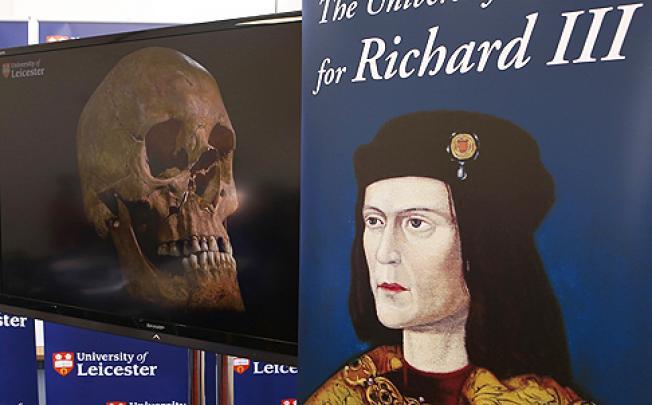
The skeleton found beneath a Leicester car park has been confirmed as that of English king Richard III.
Experts from the University of Leicester said DNA from the bones matched that of descendants of the monarch’s family.
Lead archaeologist Richard Buckley, from the University of Leicester, told a press conference to applause: “Beyond reasonable doubt it’s Richard.”
Richard III, killed in battle in 1485, will be reinterred in Leicester Cathedral.
Richard Buckley said the bones had been subjected to “rigorous academic study” and had been carbon dated to a period from 1455-1540.
Dr. Jo Appleby, an osteo-archaeologist from the university’s School of Archaeology and Ancient History, revealed the bones were of a man in his late 20s or early 30s. Richard III was 32 when he died.
His skeleton had suffered 10 injuries, including eight to the skull, at around the time of death. Two of the skull wounds were potentially fatal.
One was a “slice” removing a flap of bone, the other was caused by bladed weapon which went through and hit the opposite side of the skull – a depth of more than 10cm (4ins).
Dr. Jo Appleby said: “Both of these injuries would have caused an almost instant loss of consciousness and death would have followed quickly afterwards.
“In the case of the larger wound, if the blade had penetrated 7 cm into the brain, which we cannot determine from the bones, death would have been instantaneous.”
Other wounds included slashes or stabs to the face and the side of the head. There was also evidence of “humiliation” injuries, including a pelvic wound likely to have been caused by an upward thrust of a weapon, through the buttock.
Richard III was portrayed as deformed by some Tudor historians and indeed the skeleton’s spine is badly curved, a condition known as scoliosis.
However, there was no trace of a withered arm or other abnormalities described in the more extreme characterizations of the king.
Without the scoliosis, which experts believe developed during teenage years, he would have been about 5 ft 8 ins (1.7 m) tall, but the curvature would have made him appear “considerably” shorter.
Dr. Jo Appleby said: “The analysis of the skeleton proved that it was an adult male but was an unusually slender, almost feminine, build for a man.
“Taken as a whole, the skeletal evidence provides a highly convincing case for identification as Richard III.”

Richard was a royal prince until the death of his brother Edward IV in 1483. Appointed as protector of his nephew, Edward V, Richard instead assumed the reins of power.
Edward and his brother Richard, known as the Princes in the Tower, disappeared soon after. Rumors circulated they had been murdered on the orders of their uncle.
Challenged by Henry Tudor, Richard III was killed at Bosworth in 1485 after only two years on the throne.
He was given a hurried burial beneath the church of Greyfriars in the centre of Leicester.
Richard Buckley said the grave was clumsily cut, with sloping sides and too short for the body, forcing the head forward.
“There was no evidence of a coffin or shroud which would have left the bones in a more compact position.
“Unusually, the arms are crossed and this could be an indication the body was buried with the wrists still tied,” he added.
Greyfriars church was demolished during the Reformation in the 16th Century and over the following centuries its exact location was forgotten.
However, a team of enthusiasts and historians managed to trace the likely area – and, crucially, after painstaking genealogical research, they found a 17th-generation descendant of Richard’s sister with whose DNA they could compare any remains.
Joy Ibsen, from Canada, died several years ago but her son, Michael, who now works in London, provided a sample.
The researchers were fortunate as, while the DNA they were looking for was in all Joy Ibsen’s offspring, it is only handed down through the female line and her only daughter has no children. The line was about to stop.
But the University of Leicester’s experts had other problems.
Dr. Turi King, project geneticist, said there had been concern DNA in the bones would be too degraded: “The question was could we get a sample of DNA to work with, and I am extremely pleased to tell you that we could.”
She added: “There is a DNA match between the maternal DNA of the descendants of the family of Richard III and the skeletal remains we found at the Greyfriars dig.
“In short, the DNA evidence points to these being the remains of Richard III.”
In August 2012, an excavation began in a city council car park – the only open space remaining in the likely area – which quickly identified buildings connected to the church.
The bones were found in the first days of the dig and were eventually excavated under forensic conditions.
Details of the reburial ceremony have yet to be released, but Philippa Langley from the Richard III Society said plans for a tomb were well advanced.
She said of the discovery of Richard’s skeleton: “I’m totally thrilled, I’m overwhelmed to be honest, it’s been a long hard journey. I mean today as we stand it’s been nearly four years.
“It’s the culmination of a lot of hard work. I think, as someone said to me earlier, it’s just the end of the beginning.
“We’re going to completely reassess Richard III, we’re going to completely look at all the sources again, and hopefully there’s going to be a new beginning for Richard as well.”
[youtube KrSB3JSzAE0]
[youtube b1g_DEvYzdM]